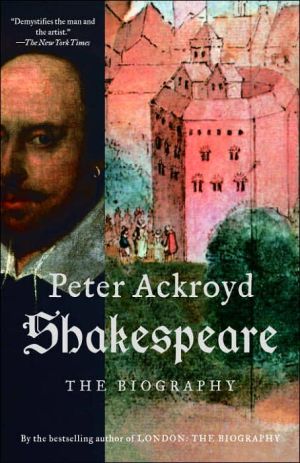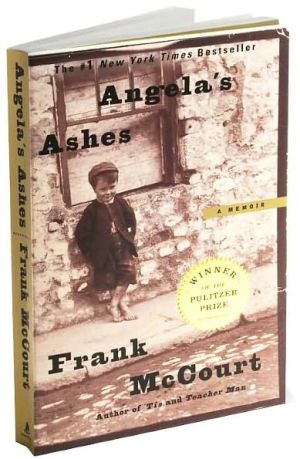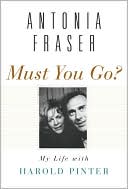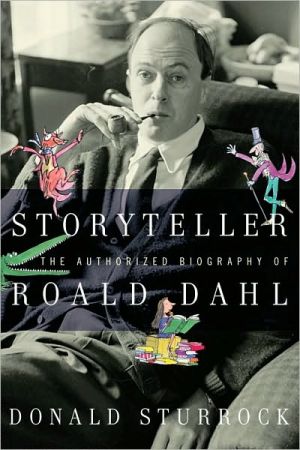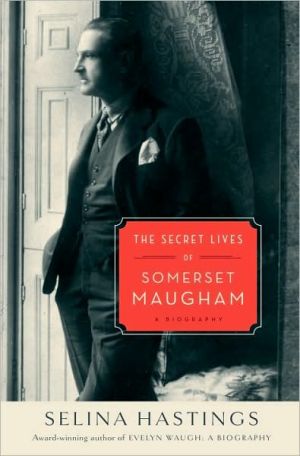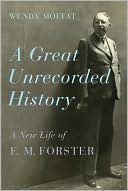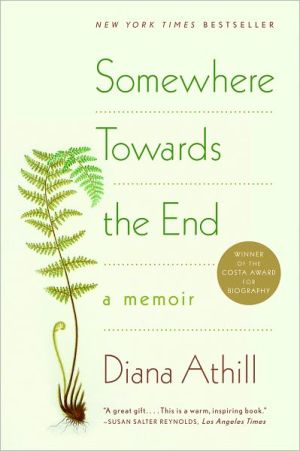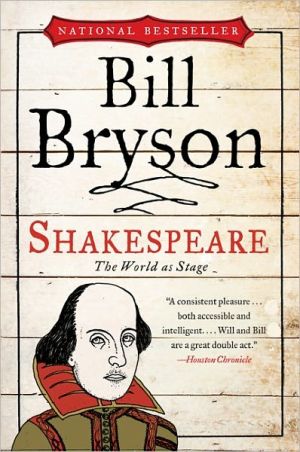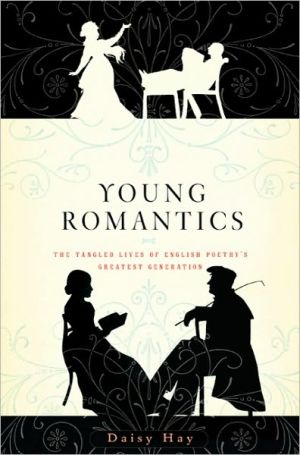Shakespeare: The Biography
Drawing on an exceptional combination of skills as literary biographer, novelist, and chronicler of London history, Peter Ackroyd surely re-creates the world that shaped Shakespeare—and brings the playwright himself into unusually vivid focus. With characteristic narrative panache, Ackroyd immerses us in sixteenth-century Stratford and the rural landscape–the industry, the animals, even the flowers–that would appear in Shakespeare’s plays. He takes us through Shakespeare’s London neighborhood...
Search in google:
This is the big one from Peter Ackroyd - and a worthy companion to London: The Biography. Only Peter Ackroyd can combine readable narrative and unique observation with a sharp eye for the fascinating fact. His method is to position Shakespeare in the close context of his world. In this way, he not only richly conjures up the texture of Shakespeare's life, but also imparts an amazing amount of vivid, interesting material about place, period and background. The New York Times - John Simon Ackroyd, though not a professional Shakespeare scholar, is a novelist, poet, critic and, above all, prolific biographer, with books on Chaucer, Thomas More, Blake, Dickens, Pound and T. S. Eliot, some of whom he aptly brings in here. Comparisons with Dickens, who was, in a way, the Shakespeare of the novel, are particularly suggestive; but Ackroyd, fruitfully, quotes many foreign opinions, old and new, as well. Especially effective is the brevity of his chapters, each dealing with a specific matter, and with a title slyly drawn from Shakespeare's words. That the endnotes are purely bibliographical, and everything else is right in the text, is also laudable.
Shakespeare\ \ By Peter Ackroyd \ Random House\ Peter Ackroyd\ All right reserved. \ ISBN: 0739323768 \ \ \ Chapter One\ Chapter 1\ \ There Was a Starre Daunst, and Under That Was I Borne\ \ \ William Shakespeare is popularly supposed to have been born on 23 April 1564, or St. George's Day. The date may in fact have been 21 April or 22 April, but the coincidence of the national festival is at least appropriate.\ \ When he emerged from the womb into the world of time, with the assistance of a midwife, an infant of the sixteenth century was washed and then "swaddled" by being wrapped tightly in soft cloth. Then he was carried downstairs in order to be presented to the father. After this ritual greeting, he was taken back to the birth-chamber, still warm and dark, where he was laid beside the mother. She was meant to "draw to her all the diseases from the child,"(1) before her infant was put in a cradle. A small portion of butter and honey was usually placed in the baby's mouth. It was the custom in Warwickshire to give the suckling child hare's brains reduced to jelly.\ \ The date of Shakespeare's christening, unlike that of his birth, is exactly known: he was baptised in the Church of the Holy Trinity, in Stratford, on Wednesday 26 April 1564. In the register of that church, the parish clerk has written Guilelmus filius Johannes Shakespere; he slipped in his Latin, and should have written Johannis.\ \ The infant Shakespeare was carried by his father from his birthplace in Henley Street down the High Street and Church Street into the church itself. The mother was never present at the baptism. John Shakespeare and his newborn son would have been accompanied by the godparents, who were otherwise known as "god-sips" or "gossips." On this occasion the godfather was William Smith, a haberdasher and neighbour in Henley Street. The name of the infant was given before he was dipped in the font and the sign of the cross marked upon his forehead. At the font the gossips were exhorted to make sure that William Shakespeare heard sermons and learned the creed as well as the Lord's Prayer "in the English tongue." After the baptism a piece of white linen cloth was placed on the head of the child, and remained there until the mother had been "churched" or purified; it was called the "chrisom cloth" and, if the infant died within a month, was used as a shroud. The ceremony of the reformed Anglican faith, in the time of Elizabeth, still favoured the presentation of apostle-spoons or christening shirts to the infant, given by the gossips, and the consumption of a christening cake in celebration. They were, after all, celebrating the saving of young William Shakespeare for eternity.\ \ Of his earthly life there was much less certainty. In the sixteenth century, the mortality of the newly born was high. Nine per cent died within a week of birth, and a further 11 per cent before they were a month old;(2) in the decade of Shakespeare's own birth there were in Stratford 62.8 average annual baptisms and 42.8 average annual child burials.(3) You had to be tough, or from a relatively prosperous family, to survive the odds. It is likely that Shakespeare had both of these advantages.\ \ Once the dangers of childhood had been surmounted, there was a further difficulty. The average lifespan of an adult male was forty-seven years. Since Shakespeare's parents were by this standard long-lived, he may have hoped to emulate their example. But he survived only six years beyond the average span. Something had wearied him. Since in London the average life expectancy was only thirty-five years in the more affluent parishes, and twenty-five years in the poorer areas, it may have been the city that killed him. But this roll-call of death had one necessary consequence. Half of the population were under the age of twenty. It was a youthful culture, with all the vigour and ambition of early life. London itself was perpetually young.\ \ The first test of Shakespeare's own vigour came only three months after his birth. In the parish register of 11 July 1564, beside the record of the burial of a weaver's young apprentice from the High Street, was written: Hic incipit pestis. Here begins the plague. In a period of six months some 237 residents of Stratford died, more than a tenth of its population; a family of four expired on the same side of Henley Street as the Shakespeares. But the Shakespeares survived. Perhaps the mother and her newborn son escaped to her old family home in the neighbouring hamlet of Wilmcote, and stayed there until the peril had passed. Only those who remained in the town succumbed to the infection.\ \ The parents, if not the child, suffered fear and trembling. They had already lost two daughters, both of whom had died in earliest infancy, and the care devoted to their first-born son must have been close and intense. Such children tend to be confident and resilient in later life. They feel themselves to be in some sense blessed and protected from the hardships of the world. It is perhaps worth remarking that Shakespeare never contracted the plague that often raged through London. But we can also see the lineaments of that fortunate son in the character of the land from which he came.\ \ \ Chapter 2\ \ Shee Is My Essence\ \ \ Warwickshire was often described as primeval, and contours of ancient time can indeed be glimpsed in the lie of this territory and its now denuded hills. It has also been depicted as the heart or the navel of England, with the clear implication that Shakespeare himself embodies some central national worth. He is central to the centre, the core or source of Englishness itself.\ \ The countryside around Stratford was divided into two swathes. To the north lay the Forest of Arden, the remains of the ancient forest that covered the Midlands; these tracts were known as the Wealden. The notion of the forest may suggest uninterrupted woodland, but that was not the case in the sixteenth century. The Forest of Arden itself included sheep farms and farmsteads, meadows and pastures, wastes and intermittent woods; in this area the houses were not linked conveniently in lanes or streets but in the words of an Elizabethan topographer, William Harrison, "stand scattered abroad, each one dwelling in the midst of his own occupying."(1) By the time Shakespeare wandered through Arden the woods themselves were steadily being reduced by the demand for timber in building new houses; it required between sixty and eighty trees to erect a house. The forest was being stripped, too, for mining and subsistence farming. In his survey of the region, for his Theatre of the Empire of Great Britaine of 1611, John Speed noticed "great and notable destruction of wood." There never has been a sylvan paradise in England. It is always being destroyed.\ \ Yet the wood has always been a token of wildness and resistance. In As You Like It and A Midsummer Night's Dream, in Cymbeline and Titus Andronicus, it becomes a symbol of folklore and of ancient memory. The great prehistoric forest of the Arden gave refuge to the British tribes against the Roman invaders of their land; the name of Arden itself derives from Celtic roots, meaning high wooded valleys. It was the Celts who named the Ardennes in the region of north-eastern France and Belgium. The same woods provided cover for the Celtic people from the marauding Saxon tribes of the Hwiccas. The legends of Guy of Warwick, imbibed by Shakespeare in his infancy, tell of the knight's hermitic concealment in the forest. His sword, used in his fight against the encroaching Danes, was kept as a memorial in Warwick Castle.\ \ So Arden was a place of concealment as well as of industry; it was an area that outlaws and vagrants might enter with impunity. That is why wood-dwellers were regarded with some disfavour by those from more open habitations. Wood-dwellers were "people of lewd lives and conversation";(2) they were "as ignorant of God or any course of civil life as the very savages amongst the infidels."(3) Thus the history of rebellion mingles with that of savagery and possible insurrection. The history runs very deep, and is inseparable from the land itself. When in As You Like It Touchstone enters the wood, he declares that "I, now am I in Arden, the more foole I" (761). Shakespeare's mother was Mary Arden. His future wife, Anne Hathaway, dwelled in the outskirts of the forest. His consciousness of the area was close and intense.\ \ Beyond the Wealden, in the south of the county, lay the Fielden. In Saxton's map of Warwickshire, issued in 1576, this region is almost wholly devoid of trees except for those growing in groves and small woods. The rest of the land had been changed to scrub and pasture, with the arable territory sweeping across the hills. In his Britannia William Camden described it as "plain champaign country, and being rich in corn and green grass yieldeth a right goodly and pleasant prospect." John Speed saw the view from the same spot as Camden, on the summit of Edgehill, and noticed "the medowing pastures with their green mantles so imbrodered with flowers." It is the quintessential picture of rural England. It was as much part of Shakespeare's vision as the forests beyond. It has been surmised that the Fielden was rich and Protestant, while the Wealden was poor and Catholic. This is the shorthand of popular prejudice, but it suggests a context for that balancing of oppositions that came so instinctively to Shakespeare.\ \ The climate of Stratford was of a mild temper, protected by the Welsh hills. There was much moisture in the land and in the air, as the various streams running through Stratford itself would have testified. The clouds from the south-west were known as "Severn Jacks" and presaged rain. Only "the Tyrannous breathing of the North," as Imogen remarks in Cymbeline, "Shakes all our buddes from growing" (257-8).\ \ But what, in the larger sense, has this landscape to do with Shakespeare or Shakespeare with the landscape? Some future genius of topography may elucidate what has become known as the territorial imperative, the sense of place that binds and determines the nature of those who grow up on a certain spot of ground. Yet, in relation to Shakespeare, we may already venture one conclusion. The evidence of his work provides unequivocal proof that he was neither born nor raised in London. He does not have the harshness or magniloquence of John Milton, born in Bread Street; he does not have the hardness of Ben Jonson, educated at Westminster School; he does not have the sharpness of Alexander Pope from the City or the obsessiveness of William Blake from Soho. He is of the country.\ \ \ Chapter 3\ \ Dost Thou Loue Pictures?\ \ \ Stratford is a meeting place of roads crossing the Avon river; afon is the Celtic name for river. The area had been settled from the Bronze Age. There were barrows and stone circles, lying now neglected, and there were "lowes" or graves where meets or open courts once gathered. A Romano-British village was established on the outskirts of the present town, lending weight and substance to the weathered and enduring atmosphere of the place.\ \ Stratford means a Roman straet, a paved road or highway, crossing a ford. In the seventh century a monastery was established, by the banks of the river; this was first in the possession of Aethelard, subordinate king of the Hwiccas, but was then transferred into the ownership of Egwin, Bishop of Worcester. Since this was soon after the conversion of the Saxons to the Christian faith, we may say that Stratford had a connection with the old religion from the earliest times. The church in which Shakespeare was baptised was erected on the site of the old monastery, and the dwellings of the monks and their servants were once on land now known as "Old Town." The Domesday surveyors of 1085 carefully noted the presence of a village on this spot, comprising farmers and labourers as well as the ecclesiastical community; there was a priest, together with twenty-one "villeins" and seven "bordarii" or cottagers.\ \ It began to prosper in the thirteenth century. A fair of three days was instituted in 1216; it was supplemented by four other fairs held at various times of the year, one of which lasted for fifteen days. A survey of 1252 reports 240 "burgages," or properties held on a yearly rental from the lord of the manor, as well as numerous shops, stalls and tenements. Here were shoemakers and fleshmongers, blacksmiths and carpenters, dyers and wheelwrights, engaged in trades that Shakespeare would still have seen on the streets of his childhood. The medieval town itself was approximately the same size as it was at the time of Shakespeare's birth. To be aware of continuity-to be settled within it-was in a real sense his birthright.\ \ The open country beyond the town has been described as "tumbled down," covered with thorn bush and populated by rabbits. There were few trees and no hedges, but flat land all around sprinkled with cowslips and clover and yellow mustard. This unenclosed territory comprised meadow land, arable land and rough pasture stretching towards the hills. Of all writers, Shakespeare has the widest vocabulary on the variety of weeds to be found in such places, disentangling the hemlock from the cuckoo-flower, the fumiter from the darnel.\ \ There had been a church in Stratford, dedicated to the Holy Trinity, since the early thirteenth century. It was erected beside the river, of local undressed stone and yellow stone from the Campden quarries, in the utmost harmony with the landscape; it possessed a wooden steeple and was surrounded by elm trees, with an avenue of lime trees leading to the north porch.\ \ Shakespeare would have known the ancient bone-house on the north side of the chancel, where the skeletons of the long-dead had been deposited; it had also been a dormitory for the singing boys and a study for the minister. Shakespeare and his contemporaries were familiar with death, although this did not prevent Juliet from crying out against the "Charnel house" with its "reekie shanks and yealow chaples sculls" (2259). Local legend suggests that the playwright had this bone-house in mind when he wrote this passage in Romeo and Juliet, and local legend may be right. His own grave was to be situated just a few feet from it, within the church itself, and his solemn curse against anyone who "moves my bones" acts as a reminder. There were other intimations of mortality: a college, or house for chantry priests praying in perpetual intercession for the dead, had been erected on the western side of the churchyard in 1351.\ \ Of equal antiquity was the Guild of the Holy Cross, established in Stratford at the beginning of the thirteenth century.\ \ Continues...\ \ \ \ Excerpted from Shakespeare by Peter Ackroyd Excerpted by permission.\ All rights reserved. No part of this excerpt may be reproduced or reprinted without permission in writing from the publisher.\ Excerpts are provided by Dial-A-Book Inc. solely for the personal use of visitors to this web site. \ \
\ From Barnes & NoblePeter Ackroyd's biographies of Blake, Chaucer, Dickens, and Sir Thomas More have established him as an acknowledged master of the genre. With a biography of Shakespeare, however, no reputation is secure: Stratford specialists generally regard all outsiders as poachers. Fortunately, Ackroyd's Shakespeare: The Biography lives up to our expectations, displaying an abundant mix of careful research and lively speculation. Too learned and wise to conjure up a definitive Shakespeare, he attempts instead to present his subject in winning multiplicity. "Ackroyd," as one reviewer said, "can riff with the best... He brings to the task of making the old facts fresh some themes and variations of his own."\ \ \ \ \ John SimonAckroyd, though not a professional Shakespeare scholar, is a novelist, poet, critic and, above all, prolific biographer, with books on Chaucer, Thomas More, Blake, Dickens, Pound and T. S. Eliot, some of whom he aptly brings in here. Comparisons with Dickens, who was, in a way, the Shakespeare of the novel, are particularly suggestive; but Ackroyd, fruitfully, quotes many foreign opinions, old and new, as well. Especially effective is the brevity of his chapters, each dealing with a specific matter, and with a title slyly drawn from Shakespeare's words. That the endnotes are purely bibliographical, and everything else is right in the text, is also laudable.\ — The New York Times\ \ \ Publishers WeeklyAt their best, Shakespearean biographers are like great jazz musicians, able to take a few notes of an old standard and spin them into dizzying riffs of conjecture. At their worst they reshuffle old wives' tales, piling supposition upon conjecture into a rickety house of cards. Peter Ackroyd can riff with the best, and he brings to the task of making the old facts fresh some themes and variations of his own that deserve a hearing. He is particularly good, in fact, on the question of sound: the way the language Shakespeare wrote, his players spoke and his audiences heard differed from the Shakespeare we hear and read today. Demonstrating the courage of his convictions, he does something daring for a book aimed at a general reader: he renders all of his citations from Shakespeare "in the original." Thus a phrase from Timon of Athens is printed: "Our Poesie is as a Goume which ouses" (rather than "gum which oozes"), an effect that can defamiliarize, often in an illuminating way. An accomplished literary biographer, Ackroyd doesn't offer a new explanation of how the glover's son of provincial Stratford became the sophisticated poetic genius of London. Instead he gives us intelligent, often elegant, variations on the old ones. Like many of his fellow biographers he warns us that a particular "tradition" has no corroboration and then plays it out anyway. So with such recent, hotly debated questions as whether Shakespeare spent time in his youth in the household of subversive secret Catholics, Ackroyd spins it out for all it's worth. But the great strength of Ackroyd's book is the depth of his immersion in the culture of Shakespeare's age and the sense he gives of Shakespeare as a product of that extraordinary moment in time. His feeling for the role of the theater in Elizabethan London, "a city where dramatic spectacles became the primary means of understanding reality," seems to come from an impressively wide reading of Shakespeare's dramatic and poetic contemporaries. His judgments about the work itself are sometimes ingenious, occasionally eccentric, as when he tells us, "All the evidence suggests, too, that the speech, `To be or not to be' is an interpolation," an unnecessary addition to Hamlet, possibly "from another play altogether." While location of "To be or not to be" is different in an early quarto of Hamlet, to say "All the evidence suggests" interpolation is an overstatement. Still, immersion in Ackroyd's biography cumulatively gives one a feeling that one has lived for a brief time in Shakespeare's world. Ackroyd constructs a an intricate mosaic of Elizabethan context, which brings us closer to the shadowy figure, whose most renowned character, Hamlet, tells us: "I have that within which passes show." Agent, Geri Thoma. (On sale Oct. 18) Rosenbaum is writing a book about controverises among Shakespearean scholars and directors (Random, fall 2006). Copyright 2005 Reed Business Information.\ \ \ \ \ Library JournalThis biography is distinguished from other contemporary Shakespeare studies by the author's ability to mesh the facts of Shakespeare's life with social, economic, literary, and political details of the 16th century. A novelist and biographer whose subjects include Charles Dickens, Thomas More, and William Blake, Ackroyd interweaves historical information with events in Shakespeare's life, revealing how the playwright was affected and inspired by contemporary events. In Ackroyd's hands, an event like Shakespeare's moving from Southwark to a more affluent area near the booksellers at St. Paul's is a springboard to report on related issues like British bookselling, publishing, and copyright. This in turn leads to a discussion of how these activities would have affected the publication of Shakespeare's works. This book is distinctly different from Stephen Greenblatt's Will in the World and Michael Wood's Shakespeare; though all three biographies use the same basic information, Ackroyd transforms the black-and-white sketch of Shakespeare into a richly colored portrait. Highly recommended for all public and academic libraries. [See Prepub Alert, LJ 6/1/05.]-Shana C. Fair, Ohio Univ. Lib., Zanesville Copyright 2005 Reed Business Information.\ \ \ \ \ School Library JournalAdult/High School-Describing himself as a Shakespeare enthusiast instead of an expert, Ackroyd focuses on the bard as an extraordinarily talented theater professional rather than rhapsodizing about the intricacies of the man's genius. He interweaves Shakespeare's life story with England's dramatic history and the fascinating world of the emerging Elizabethan theater. Apocryphal stories are identified and plausible explanations for what occurred during the "missing" years are offered. Shakespeare emerges as a thoroughly engaging, almost modern man, brimming with humor, eager for social advancement, and carefully tracking the popular trends in entertainment. Students who want to discover whether Shakespeare really was the author of the famous plays will find compelling evidence that only the man from Stratford could have hidden so many ingenious clues in his work. Sixteen pages of color illustrations include portraits of Shakespeare's famous contemporaries, photographs of the interiors of Elizabethan buildings, and illustrated title pages. Those daunted by the length of this book will find it a good reference source. Students looking for information on the building of the Globe, the meanings of the sonnets, the differences in the various editions and revisions of the plays, and other typical academic questions will find useful, well-organized information. A rich, vivid account.-Kathy Tewell, Fairfax County Public Library, VA Copyright 2005 Reed Business Information.\ \ \ \ \ Kirkus ReviewsAckroyd (Chaucer, Jan. 2005, etc.) continues his exploration of his native country's imaginative landscape with a portrait of the life and times of the quintessential English artist. Given the enormous amount of attention devoted to the life of William Shakespeare (1564-1616) in the four centuries since his death, it's hard to offer something truly new about either the man or his plays. Ackroyd doesn't, but his discursive biography capably synthesizes current knowledge with just enough of a point of view to make it interesting. He's solid on Shakespeare's origins in a family of recusant Catholics-a fairly new but now generally conceded point-and on the Bard's rise in dynamic, rapidly changing Elizabethan society: "a young man's world in which ambition and aspiration might lead anywhere and everywhere." But the author sometimes gets perilously near radical oversimplification when he suggests that the writer merely threw hordes of great characters onto the stage in plots whose plundered sources he barely bothered to alter. The extensive historical background ranges from marvelously atmospheric material on Elizabethan theater, which illuminates the network of rivalries and camaraderie within which Shakespeare operated, to tedious references to academic disagreements about which the general reader will care naught. We get a wonderful sense of Shakespeare's personality: educated but not particularly intellectual, ambitious, shrewd about money, eager to reassert his family's genteel origins, something of a philanderer, suspicious of all dogma. Ackroyd offers less compelling material, stressing Shakespeare's fluency and fertility, his ability to cannibalize others' work and shape it to his ownends, without being very specific as to what exactly those ends were. Newcomers to Shakespearean studies will find this a good place to start. Those more familiar with the field will find that it palls in comparison to Stephen Greenblatt's Will in the World (2004).\ \
